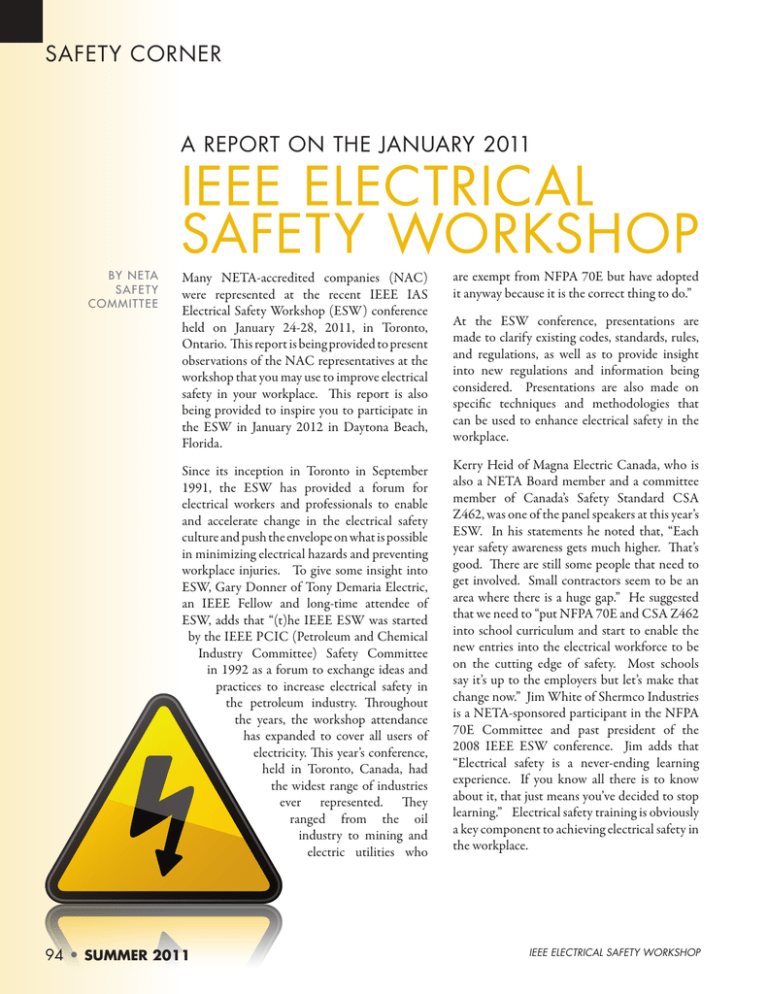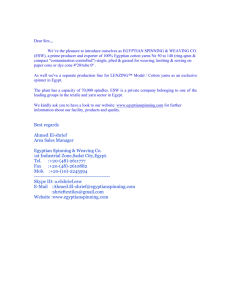ieee electrical safety workshop
advertisement

SAFETY CORNER A Report on the January 2011 By NETA S a fe t y C o m mit t e e IEEE Electrical Safety Workshop Many NETA-accredited companies (NAC) were represented at the recent IEEE IAS Electrical Safety Workshop (ESW) conference held on January 24-28, 2011, in Toronto, Ontario. This report is being provided to present observations of the NAC representatives at the workshop that you may use to improve electrical safety in your workplace. This report is also being provided to inspire you to participate in the ESW in January 2012 in Daytona Beach, Florida. are exempt from NFPA 70E but have adopted it anyway because it is the correct thing to do.” Since its inception in Toronto in September 1991, the ESW has provided a forum for electrical workers and professionals to enable and accelerate change in the electrical safety culture and push the envelope on what is possible in minimizing electrical hazards and preventing workplace injuries. To give some insight into ESW, Gary Donner of Tony Demaria Electric, an IEEE Fellow and long-time attendee of ESW, adds that “(t)he IEEE ESW was started by the IEEE PCIC (Petroleum and Chemical Industry Committee) Safety Committee in 1992 as a forum to exchange ideas and practices to increase electrical safety in the petroleum industry. Throughout the years, the workshop attendance has expanded to cover all users of electricity. This year’s conference, held in Toronto, Canada, had the widest range of industries ever represented. They ranged from the oil industry to mining and electric utilities who Kerry Heid of Magna Electric Canada, who is also a NETA Board member and a committee member of Canada’s Safety Standard CSA Z462, was one of the panel speakers at this year’s ESW. In his statements he noted that, “Each year safety awareness gets much higher. That’s good. There are still some people that need to get involved. Small contractors seem to be an area where there is a huge gap.” He suggested that we need to “put NFPA 70E and CSA Z462 into school curriculum and start to enable the new entries into the electrical workforce to be on the cutting edge of safety. Most schools say it’s up to the employers but let’s make that change now.” Jim White of Shermco Industries is a NETA-sponsored participant in the NFPA 70E Committee and past president of the 2008 IEEE ESW conference. Jim adds that “Electrical safety is a never-ending learning experience. If you know all there is to know about it, that just means you’ve decided to stop learning.” Electrical safety training is obviously a key component to achieving electrical safety in the workplace. 94 • SUMMER 2011 At the ESW conference, presentations are made to clarify existing codes, standards, rules, and regulations, as well as to provide insight into new regulations and information being considered. Presentations are also made on specific techniques and methodologies that can be used to enhance electrical safety in the workplace. IEEE Electrical Safety workshop SAFTEY CORNER Tony Demaria of Tony Demaria Electric and the NETA Safety Committee Chairman adds, “The goal of electrical workplace safety is clear… no injuries. The path to get there is very difficult, expensive, time consuming, and frequently confusing. No field worker can turn difficult and confusing information into safe work practices. Our job is to make clear, concise, and consistent safety policies and procedures. It is hard to make difficult things simple. I am going to do my best to have clear policies at our workplace.” Tony adds that “You can have the best safety policies and procedures in the universe. You can have the most extensive safety training program in the country. If you are not field-verifying that the workers are following the policies and procedures, you do not have a safety program.” Tony further suggests “assigning one of (y)our top technicians to a full time safety position at (y)our company to field verify compliance with safety policies and procedures. This person will report to (y)our company’s safety committee, which includes top management. Their findings will be incorporated into (y)our never ending commitment to improve (y)our safety policies and procedures.” Dennis Green, Safety Director of Tony Demaria Electric, adds that “It is a slow road to get the customer, the engineer, and some contractors to start pushing arc-rated equipment, remote racking, and remote switching. It shows that the mentality of the industry is far behind and that education, regulations, policy, and procedures still need to change. Until people are educated on the fact that these changes are for the better, will keep people alive, and lower their exposure, no changes will occur.” Further, Dennis Green observes that “(w)e are not the only company struggling with the problem of changing human behavior, as presented in the paper titled, IEEE Electrical Safety workshop A Serious Near Miss. To me, the near miss incident in the paper was caused by look-alike equipment. I believe that look-alike equipment can be a killer and needs to be taken extremely seriously. In this case, it was luck that no one was hurt.” Jim White adds that “Just because you cut corners and did not immediately die does not mean that it is now the right way to do things.” Safety procedures and policies are also a key component to a successful safety program. However, just having safety policies and procedures in place is not enough. You must also perform safety program audits and have a continuous improvement process in place for your safety policies and procedures. This conference also included active discussions on electrical safety hazards and risk management. Tony Demaria observed that “there is much disagreement and much confusion as to the definitions and differences between the words hazard and risk. Until we come to an industry-wide agreement as to the definitions of these words, we will have a serious gap in our understanding of how to communicate safety to each other.” Kerry Heid adds that “hazard and risk are two entirely different things and many people don’t understand it. Eliminate, control, protect. PPE is the last solution. It’s like driving your car without any driver training or any concern for the road signs because “I have an airbag”. Maintenance is the trump card. All bets are off if it doesn’t work the way it was designed. Equipment condition needs to be formally written into the risk assessment NETAWORLD • 95 SAFETY CORNER process.” Dennis Green adds, “As an industry, we still blindly put men in places where they have no business being. Why have PPE that has a breakout value of 50 percent, why not go for the 100 percent? That’s how I see it when they talk about the breakout value on arc-rated PPE.” Dennis Green learned some other things from this conference, “We should be sending anyone that receives an electrical shock to the doctor to be checked out. Dr. Joel spoke about the invisible injury, which is a great name since electricity is invisible.” Dennis also “found that many companies have problems with bidding procedures. When awarding bids without understanding what the risk and hazards are, workers will continue to be hurt or killed. A bid should be awarded based on, 1) safety records, 2) qualifications and experience, and 3) the dollar amount. What is not understood is that the lowest bid is not always the best bid. Make sure your contractors are qualified to do what they say they can do.” With regard to electrical safety, a dialogue on hazard and risk assessment will continue. The IEEE ESW conference is held each year to present ideas that may be put into practice to improve electrical safety in the workplace. From the recent ESW conference, the following summarizes some of the presentations that were notable to the NAC participants: Given the range of participation in the ESW conference, attending companies are introduced to information and technology that can be transferred into techniques and procedures that will make the workplace safer. Gary Donner stated that “(a) very practical screening tool was explained in one of the workshops. It was an ultrasonic hand-held instrument that can scan enclosed electrical apparatus prior to opening the door. This method can detect arcing, tracking, and corona in low and high voltages. By detecting one of these problems you may decide to shut the equipment down prior to opening the door. The life you save might be yours. We are going to purchase several more of these instruments and incorporate their use in our procedures.” There are new technologies that can be implemented to enhance safety in the workplace. It is obvious from this report that issues associated with electrical safety in the workplace are still actively being discussed and dealt with in various affected industries. There is much we can learn as a collective group to deal with these issues. As Tony Demaria explains it, “Safety is a journey, not an end. None of us can do everything, but each of us can do something to make a difference.” NETA encourages each NAC to become active participants in conferences like IEEE ESW and then share the experience and information with others in the industry so that all can benefit. 96 • SUMMER 2011 •Electrical safety training is a key component in achieving electrical safety in the workplace. •Safety procedures and policies are also key components in a successful safety program. However, just having safety policies and procedures in place is not enough. Safety program audits and a continuous improvement process for safety policies and procedures must also be included. •A dialogue on hazard and risk assessment will continue. •There are new technologies that can be implemented to enhance safety in the workplace. IEEE Electrical Safety workshop

